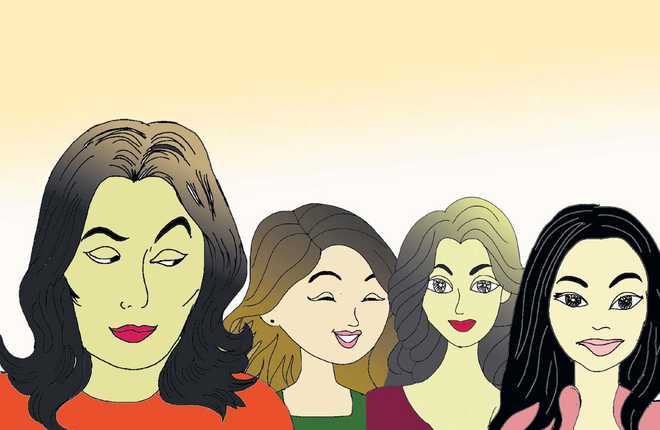Giving the side-eye… and being sidebarred…
Harvinder Khetal
SO, the simple sidebar has now, also, silently slipped into the secretive, surreptitious sphere. How? First let’s see how the sidebar has been variously known to us:
- For the common man, a sidebar is a secondary, additional, or incidental thing; a side issue.
- For journalists, like me, when the editor tells me to put in a sidebar in the story, he is asking me to place a short piece alongside the main article to complement it by giving additional or explanatory material. Also called sidelight (of a major news story), it may be a backgrounder, history, a light incident, related perspective, opposite view, some examples, a graphic, a map or an illustration.
- A lawyer would associate the sidebar with a conference between the judge, the lawyers, and sometimes the parties to a case that the jury does not hear.
- The computer user — and most of us are one — would at once bracket the sidebar with (in a graphical user interface) a narrow vertical area that is located alongside the main display area, typically containing related information or navigation options. It’s generally the place where one houses shortcuts to one’s favourite folders and other tools.
But now, in the hyper-connected, instant-messaging world of today, sidebar has an additional definition. This is one that we all will at once relate to. And, interestingly, most of us have, variously, been both victims of as also guilty of sidebarring! So, what’s this ubiquitous business that has been finally given the name of sidebarring?
The Macmilan Dictionary defines sidebarring as the practice of carrying out a secret conversation via your phone while you’re in a meeting or at a party.
Ugh! Yes, it’s that rude, obnoxious practice!
You have just warmed up to a nice tete-a-tete and are settling into a cosy conversation, when from the side-eye you notice your companion whip out his smartphone, and surreptitiously indulge in chatting. It makes you, the one present in the moment, almost cringe with the feeling of being less important than some fellow sitting afar, even as you try to put on a smiling face even as you grit your teeth in anger. Sidebarring is the rudest thing you can do with a phone.
If you think, by doing so you are multi-tasking, you are wrong. Because it is not possible to text and pay attention to real life conversation at the same time, as revealed by a 2015 study published in the Journal of Neuroscience. Experts reckon that focusing on a visual task, such as typing on a phone or computer, can make us deaf to sounds around us — a syndrome they’ve dubbed “inattentional deafness”.
Of course, you would not deny being guilty of sidebarring, too. If not with the intention of being rude, then definitely for fobbing off an unwanted bore or unnecessarily prolonged meeting or conversation. Even if you are side-eyed.
So, what’s this side-eyeing business?
Merriam Webster Dictionary defines side-eye as a sidelong glance or gaze especially when expressing scorn, suspicion, disapproval, or veiled curiosity. Remember when Michelle Obama side-eyed Melania Trump during the swearing in of Donald Trump as US President?
Or, when you eyed that beautiful girl in college getting all the attention of all people around in that freshers’ party, before you found your own little group to seek solace in?
The dictionary, with its eye on this word, gives an indepth account of the usage and history of side-eye. It says that chances are you've been on both ends of the side-eye. It's that sidelong look, that glance or gaze that doesn't want to involve the front of the face, but instead says way more by shifting to the corners of the looker's eyes.
One other thing about side-eye is that there's some debate about what exactly side-eye is—in particular, about whether or not a turn of the head disqualifies a sidelong glance from being side-eye. Some say you have to keep your head steady and straight ahead and do it all with your eyes.
The dictionary quotes the earliest evidence of side-eye in use from 1797:
Here we come to what calls for the strongest eye-sight, the most steadfast gazing. Our being in Adam has been looked on with a side eye. The subject has provoked dislike; I may almost say, contempt. It is now painful to speak of it. — Remembrancer For Lord's Day Evenings, March 19, 1797
Then there is this evidence of verb use, with the earliest example dating to 1916:
In his mind's-eye he saw himself associating with actor-folk, who invariably side-eye him and whispered among themselves: "That's Alonzo Gubbins—frightfully wealthy—just about the real backing of the Frohman ventures--though, of course, Frohman is putting up the name and reputation!"
—The Arizona Republican, August 26, 1916
As a journalist, I appreciate the use of the word in this telling headline in Inverse (inverse . com), on March 9, 2016:
With Zika Virus Headed North, American Scientists Side-Eye Asian Tiger Mosquitoes.
hkhetal@gmail.com










